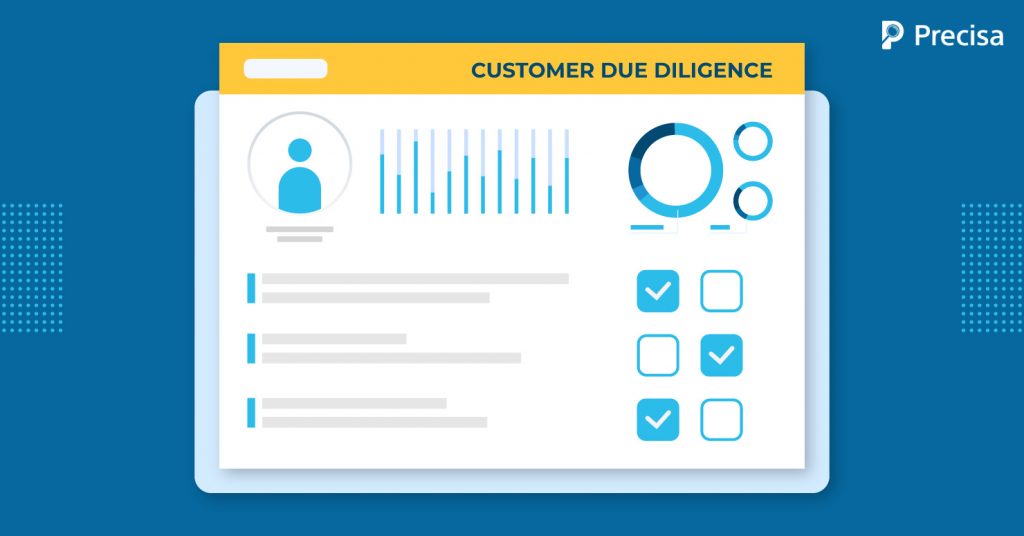Role of Customer Due Diligence in Lending

Lending is a risky affair. It always poses the threat that what if the lent money or the item(s) are not returned. It sure requires a lot of trust on the part of the lender but trusting an unknown individual or business entity can misfire and lead to grave troubles. In financial lending, banks and NBFCs need to know whom they are lending before entrusting them with their money.
This gives birth to the term Know Your Customer (KYC) to verify the borrower. But a simple KYC check is not enough when countless bad loans and NPAs are threatening the Indian banking industry.
But there’s one way lenders can better manage the lending risks and make well-verified loan sanctions. This process is called Customer Due Diligence.
Let us know what Customer Due Diligence is and how it helps banks and NBFCs make better decisions.
What is Customer Due Diligence?
Customer due diligence is a way to know a customer’s financial and legal background to decide whether or not to provide them with a loan. Also, lenders can determine the amount of money the customer will be able to repay.
With increased money laundering and fraudulent activities, assessing a person’s background before lending any money has become critical. So, most financial lending institutions employ AML/CFT measures to verify their customers’ identities and the nature of their business(es).
For this, they seek the applicant’s name, photograph, KYC proofs, and other financial transaction documents. Know Your Customer (KYC) is born out of the Prevention of Money Laundering Act (PMLA), 2002, and needs to be performed.
Additionally, customer due diligence plays a critical role in identifying anti-national organisations, thus, defusing terrorist activity before it is too late. Often, money is laundered to fund such organisations, and CDD helps in efficiently assessing them.
The Levels of Customer Due Diligence
Customer due diligence has three levels and based on the risks involved, the lenders choose one of the three measures:
Standard Due Diligence
As the name suggests, this is the standard level of CDD and is used for every customer. It includes the identification of the customer through various documents. This is the norm while approving common personal loans, mortgage loans, etc.
All the customer’s details are verified at this level to avoid any ruckus after issuing the loan. Lending institutions must also know the purpose of the loan to avoid any fraud and carefully assess all the related documents.
Standard due diligence ensures that loans are given to the right people for legitimate work. This, to a large extent, rules out the possibility of funding illegal activities.
Simplified Due Diligence
Banks, NBFCs, and other lending institutions calculate the risk of lending money to an individual or a business. If the calculations reveal a low risk of money laundering or fraud, simplified due diligence is used. At this level, verifying the customer’s identity is not necessary. Banks and NBFCs should only know who the customer is, and this is sufficient to issue the loan, which is most often for a very small amount.
Enhanced Customer Due Diligence
In cases of high-risk clients or large loan amounts, enhanced customer due diligence is followed. At this level, additional identity verifications are carried out in accordance with the laws of the country and the institution’s policies. In addition, the source of income and the purpose of the loan are also considered by the lenders. Lastly, the customer might also be subjected to ongoing monitoring procedures by the lending institution.
How Customer Due Diligence Makes Lending Risk-Free for Banks and NBFCs
Customer due diligence considerably impacts money lending by banks, NBFCs, and other lending institutions. Lenders can also use digital platforms for the analysis of bank statements. CDD plays a vital role in ensuring that money is lent to people for legitimate work and will be repaid before the due date.
Various parameters are considered during the CDD process:
1. Validating Identity
Identity verification is one of those things that cannot be avoided while lending money. Banks and NBFCs should ask people to show their documents that are legit in a particular jurisdiction.
Today, it is easy to create fake documents and therefore, banks and NBFCs should also check whether the applicant’s documents are real or fake. This includes cross-checking name, photographic ID, address, birth certification, and all business licenses (if applicable) from an independent source. In addition, the financial statements of the customer should also be verified.
2. Business Holdings
Banks and NBFCs do not only provide loans to individuals but also to various businesses and organisations. However, before lending money to any business or organisation, money lenders must find out about the company’s ownership.
Banks and NBFCs should check whether the owners of the company exist or not and where the owners are based from. There are high chances of money laundering and fraud being executed by presenting misleading information on ownership.
This is where customer due diligence is an effective tool. It helps lenders know more about the promoters or holders of a company and also confirms whether the people claiming to be the owners of a company actually own it or not.
3. Present and Future Prospects
Whether money is being lent to an individual or a business, lenders need to know the purpose of the loan and the ventures they are willing to enter.
If the borrower has taken a loan previously, CDD will examine all the details and assess whether the borrower has been timely with the repayments.
The banks and NBFCs can also analyse the bank statement through an online tool that can give an insightful look into the applicant’s financial history.
Summing up, these three critical parameters assessed through CDD eventually help lenders distribute loans intelligently.
If you’re looking for a robust tool to analyse the financial statements of loan applicants at scale, Precisa can be your go-to option. Opt for our 14-day free trial.



